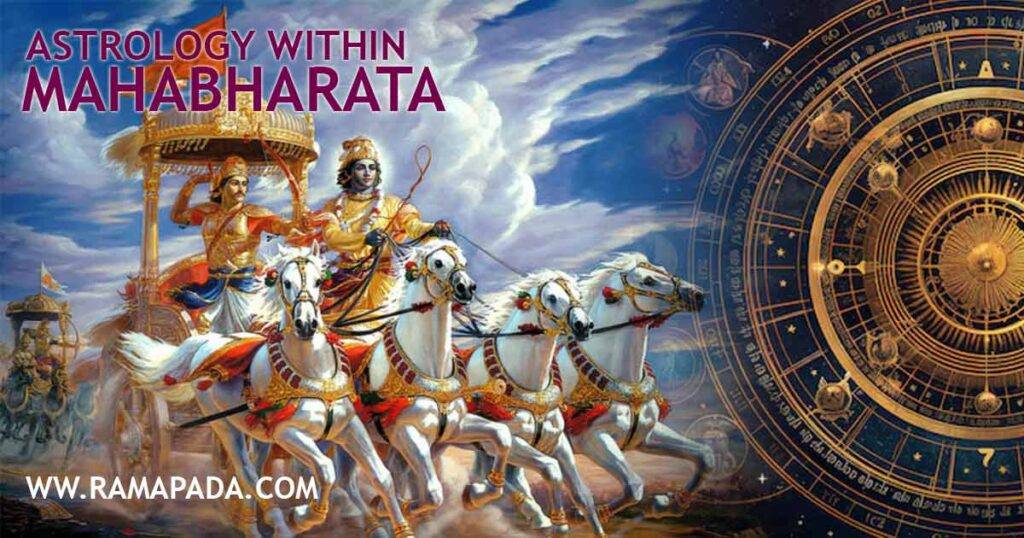The Mahabharata, India’s timeless epic, is not only a saga of dynastic conflict and spiritual awakening—it is also a cosmic drama, where astrology (Jyotisha) serves as a guiding force behind fate, free will, and divine orchestration. From planetary alignments to omens and ritual timings, astrology weaves through the narrative as both a symbolic and functional force. “Astrology Within Mahabharata” shines like a hidden constellation, revealing the deeper currents of fate and dharma.
Cosmic Determinism and Human Agency
Astrology within Mahabharata is not passive fortune-telling—it is active cosmology. Characters act in accordance with celestial signs, and their destinies unfold in sync with planetary rhythms.
- Bhishma’s vow and death: Aligned with cosmic timing, he chooses to die during Uttarayana, the sun’s northward journey, considered auspicious for liberation.
- Duryodhana’s birth: Marked by terrifying omens and planetary disturbances, prompting Vidura to warn of impending doom.
- Krishna’s strategic counsel often includes choosing the right Muhurta (auspicious time) for war and rituals.
Planetary Alignments as Portents of War
The epic vividly describes astrological phenomena that foreshadow the Kurukshetra war:
- Saturn afflicting Rohini Nakshatra—a sign of mass destruction.
- Mars moving toward Jyeshtha, indicating bloodshed.
- Solar and lunar eclipses occurring unusually on the 13th day of the lunar cycle—interpreted as signs of cosmic imbalance.
These alignments are not mere literary devices—they reflect the Vedic worldview where planetary movements mirror moral and spiritual crises.
Characters as Astrological Archetypes
Many characters in the Mahabharata embody traits associated with zodiac signs and planetary influences:
| Character | Planetary Influence | Traits Reflected |
| Bhishma | Saturn | Duty, discipline, sacrifice |
| Arjuna | Jupiter/Venus | Wisdom, skill, philosophical depth |
| Karna | Sun | Pride, loyalty, quest for recognition |
| Draupadi | Moon/Venus | Emotional intensity, beauty, justice |
| Duryodhana | Mars/Saturn | Ambition, aggression, karmic burden |
| Krishna | Mercury/Aquarius | Cosmic intelligence, detachment, vision |
These associations offer a symbolic lens to understand the psychological and karmic depth of each figure.
Rituals, Muhurtas, and Cosmic Law
Astrology governs not just fate but ritual precision in the epic:
- Yagnas (sacrificial rituals): Performed at astrologically chosen times to invoke divine blessings.
- Exile periods and their completion: Debated based on lunar vs. solar calendars, as seen in the Pandavas’ return from Agyatvas.
- Bhishma Ashtami: The day of Bhishma’s death, still observed as astrologically potent for ancestral offerings.
Legacy in Contemporary Practice
The astrological wisdom of the Mahabharata continues to shape Indian cultural and spiritual life:
- Marriage Muhurtas, naming ceremonies, and death rituals often follow principles echoed in the epic.
- Planetary omens: Still interpreted during political events, eclipses, and natural disasters.
- The epic’s emphasis on timing and dharma reinforces the belief that aligning with cosmic rhythms leads to harmony.
Conclusion: The Stars as Storytellers
In the Mahabharata, astrology is not superstition—it is sacred science, a language through which the universe speaks. It reveals that human lives are not isolated events but threads in a cosmic tapestry, where every action, vow, and battle echoes the movements of the stars. Ramapada Acharjee says “Astrology Within Mahabharata” reveals how celestial rhythms guide the epic’s key decisions, battles, and spiritual revelations.

